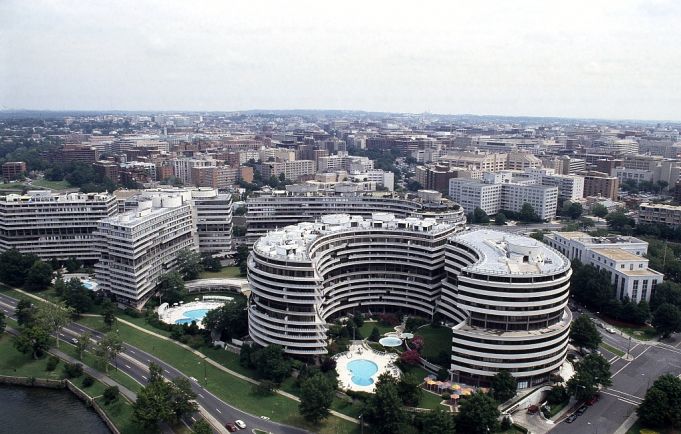Italian connections to the infamous Washington landmark.
Until the break-in that occurred the night of 16 June 1972 in the offices of the Democratic National Committee, the Watergate was known primarily as a place of luxury and privacy. In the decades since, of course, the place has become synonymous with scandal.
I recently had the opportunity to write the complete history of the Watergate complex, beginning with the original purchase of the vacant land in February 1960 to the present day. I interviewed current and former residents and unearthed documents from a variety of sources, including the libraries of 13 US presidents and the National Archives.
My journey into the Watergate’s past also led me to Rome.
On a cold November day at the Central State Archives in the EUR district, my associate Anthony Majanlahti and I examined the records of a long-forgotten construction company named Società Generale Immobiliare. The corporate board minutes were fragile and difficult to read, held together with paper clips that were caked with rust.
From these documents and other research, a cast of Italian characters revealed themselves, including Luigi Moretti, the temperamental Roman architect who designed the Watergate, and Duke Arturo Pini di San Miniato, an interior designer from Bologna with a questionable claim to noble lineage.
But by far the was the most intriguing Italian with a personal connection to Watergate was the infamous Michele Sindona, the Sicilian banker at the centre of one of the greatest scandals in Italian financial history.
***
Società Generale Immobiliare (SGI), was once the largest real estate development and construction firm in Italy, as old as Italy itself. Founded in Turin in 1862, SGI moved its headquarters to Rome in 1870. Over the decades, SGI cleared slums, enlarged plazas throughout Rome, and created large developments outside the city. For the 1960 Olympics in Rome, SGO built the Olympic Village. In February 1960, SGI purchased two plots of land, totaling 10 acres and “centrally located” on the shores of the Potomac River, at a total cost of $3.75 million (about $318 million today), on which to build its first massive project in North America, which would become known as the Watergate.

In 1969, the Italian parliament voted to require the Vatican to pay taxes on its dividend income from Italian companies. At the time, the Catholic Church held a vast portfolio of stock in Italian companies, including a controlling interest in SGI.
Pope Paul VI turned for help to Michele Sindona, a lawyer, originally from Palermo, who at the time specialised in tax issues from his office in central Milan. Sindona had been useful to the Vatican just two years earlier, when he persuaded the government of Aldo Moro to delay implementation of a similar proposal.
“This is a terrible problem,” the pope sighed, according to one account of the meeting. If the Vatican allowed Italy to tax its investments, he feared, it would be a signal for other countries to do the same.
Sindona proposed the Church move its investments out of Italy. This would protect the confidentiality of the Vatican’s investments, Sindona promised, and demonstrate to other countries the Vatican’s willingness to play hardball. The pope agreed, and Sindona promptly found a buyer for the Vatican’s shares in SGI: himself.
***
In July 1972, Sindona paid $40 million in cash for a controlling interest in the holding company of Franklin National Bank. Sindona recruited a man named Peter Shaddick to manage the bank’s international division. Franklin’s foreign exchange trading, according to a detailed history by Joan Edelman Spero, would “push the bank over the brink to disaster.”
Shaddick’s traders were inexperienced. In January 1973, expecting the US dollar to rise, they took short positions in various currencies – but the dollar fell sharply. On 14 May, Italian newspapers reported Franklin’s staggering losses.
Banca di Roma extended $200 million in credit to Sindona, who put up his shares in SGI as collateral. Within a few months, Sindona’s entire line of credit had been used up and future losses from “unrecorded speculation and transactions” by Sindona could be “major.” Italian regulators discovered an additional $50 million in foreign exchange losses and prosecutors issued a warrant for Sindona’s arrest.
On 3 October 1974, Sindona resigned from the board of SGI. Franklin National Bank was declared insolvent a week later, the largest bank failure in US history. Banca di Roma took control of Sindona’s stake in SGI and quickly sold these shares to a consortium of Roman developers known as pallazinari.
On 22 March 1986, four days after an Italian court convicted Sindona of arranging the assassination of Giorgio Ambrosoli in 1979, the liquidator of his financial holdings, Sindona was found dead in his prison cell after drinking coffee laced with cyanide. “They have poisoned me,” he told a prison guard, just before collapsing into a coma.
Italian newspapers called the scandal “il caso Sindona.” In America, Business Week magazine called it by another name: “Italy’s Watergate.”
By Joseph Rodota

Rodota (pictured above) is the author of THE WATERGATE: Inside America’s Most Infamous Address (William Morrow).
Cover image: From the studio of Luigi Moretti (1907-1973), architect of the Watergate.


















